Cadaujac, Gironde, Nouvelle-Aquitaine 作者: 来源: 发布时间:2021-06-10
I.Population and Area
Total Area: 15.33 km2
Population in 2017: 6 097
Population Density: 398 /km2
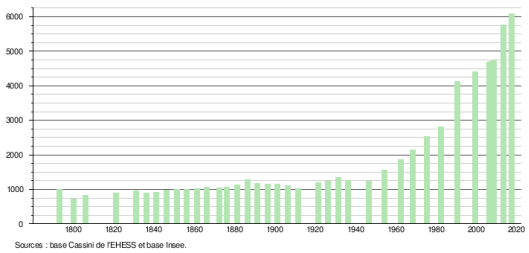
Histogram of demographic change
II.Natural Geography (environment and resources)

Cadaujac is a town in southwestern France, located in the Gironde department in the Nouvelle-Aquitaine region.
Municipality of the urban area of Bordeaux located in its urban unit. Cadaujac is a town in the Canton of La Brède, located 10 km south of Bordeaux, extends for 6 km along the Garonne.
Hydrography:
The town is located on the Garonne and the Eau Blanche
Natura 2000
Like Saint-Médard-d'Eyrans, Cadaujac is part of natural or semi-natural sites with great heritage value, an area which concerns the part close to the Garonne.
Flood risk prevention plan for Cadaujac.
Communication routes and transport: Cadaujac can be reached by the Rocade (exits Exit 18a and Exit 20), or by the motorway towards Toulouse A62 (Exit 1), as well as by the SNCF station of Cadaujac. Cadaujac has an SNCF train station, an interchange on the A62 motorway (Bordeaux-Toulouse) and it is crossed by the departmental road 1113. The town is 15 minutes from the Saint-Jean SNCF train station in Bordeaux and 20 minutes from Bordeaux-Mérignac international airport.
Public transport:
1)TBM network
The TBM network, formerly TBC until 2016, served the municipality, via line 89 connecting it to Villenave-d'Ornon. This service has been discontinued since 2016 for financial reasons, following the decision taken at the end of 2014 by the Departmental Council of Gironde to stop participating in the financing of the line. Cadaujacais now have to go to Villenave d'Ornon to use the TBM network.
2)Trans Gironde network
Line 503 linked the Peixotto tram station to Saint-Symphorien.
III.Economy
Employment rate (%): 79.4 (2017)
Poverty rate by age group of the tax advisor(%): 7 (2017)
Average employment income (€):2 279 net per month (27 350 net per year)(2014)
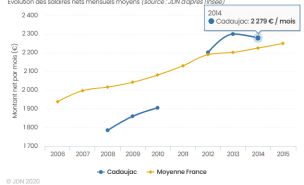
Evolution of average monthly net wages
Sources : http://www.journaldunet.com/business/salaire/cadaujac/ville-33080
https://insee.fr/fr/statistiques/2011101?geo=COM-33080
IV.Industrial Characterisitics
Sectors of activity most represented in Cadaujac:
The table below lists the five activity sectors with the most companies in Cadaujac during the period from 24/09/2019 to 24/09/2020 as well as the share of each sector on the total number of 'enterprises of the municipality.
Sector of activity | Number of companies | Share of companies |
Rental and operation of own or leased real estate | 162 | 17.6% |
Finishing works | 52 | 5.6% |
Electrical, plumbing and other installation work | 40 | 4.3% |
Other specialized construction work | 37 | 4.0% |
Other human health activities | 36 | 3.9% |
Viticulture :
As a wine-growing municipality in the Graves vineyard, Cadaujac is authorized to produce wines: AOC Pessac-Léognan, AOC Crémant de Bordeaux, AOC Bordeaux Supérieur, AOC Bordeaux, AOC Graves and AOC Graves Supérieur29.
For the A.O.C. Pessac-Léognan we find the following producers: Château Bardins; Baulos-Charmes Castle; Chateau Bouscaut; Château Lamothe-Bouscaut; Eck Castle; Chateau Valoux.
Industry and commerce
Enjoy 33 is a local radio station broadcasting a generalist program centered on the Bordeaux metropolis. It covers around 90% of the Gironde department.
History:
Originally known in 2004 under the name of TRG (Télé Radio des Graves), it was renamed TRG (The Radio Girondine) in 2009, then Enjoy 33 in June 2011. Originally located in Castres-Gironde1, its studios are now located in Cadaujac, a town very close to Bordeaux.
Programming:
Mixing local information, practical sections (traffic information, weather forecasts, ideas for outings) and music (2000s, current trends and exclusives), ENJOY 33 primarily targets young people and active adults. Its program schedule includes 40% French and French-speaking music, the station positioning itself above all on Latin music and RnB.
Other musical events appreciated by its listeners: the Enjoy Club, every Friday and Saturday in particular with mixes of Girondin DJs.
Above all a “city” radio, it broadcasts many services focused on life in the Bordeaux conurbation (20 daily road points reporting traffic disruptions, local and departmental information, alerts in the event of accidents or slowing down of urban transport, and many ideas for outings).
Diffusion:
It transmits in frequency modulation. TRG obtained its broadcasting license from the CSA in 1992.
Sources: http://entreprises.lefigaro.fr/cadaujac/ville-33080
V.Attractions
1.Right House
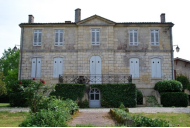
Maison Droit, listed as a historical monument in 1988.
The house was probably erected in the second half of the 18th century. Like all the estates along the banks of the Garonne, access was via the river, as evidenced by an old filled arm and the noble facade, facing the river.
Rectangular in plan, the house has a basement floor surmounted by a raised ground floor and a first floor. The central bay of the main facade, slightly projecting and topped with a triangular pediment, opens with a semicircular arch door. This is preceded by a flight of steps whose access is via a staircase with two parallel climbs. The south facade, without decoration, has a staircase with two divergent ascents. Much later outbuildings were built to the west of the house.
2.Saige castle
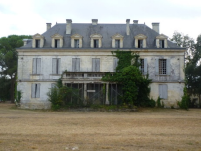
Château de Saige, listed as a historical monument in 1983.
François-Armand de Saige, former advocate general at the Parliament of Bordeaux, elected mayor of the city in 1791 and guillotined in 1793, would have had this castle built on a gravelly site overlooking the palus of the Garonne. The 14 hectare estate is located in a prestigious park.
Rectangular in plan, the construction was extended by a building with a hemicycle-shaped terrace. The facades are developed on three levels. Triangular pediments crown each dormer, except the central one, which has an arched pediment and thus marks the symmetry of the upper composition. On the ground floor, the entrance is completely off-center to the west. A porch with four Tuscan columns is added to the north facade. The interior has been completely transformed. On the first floor, a door with its old decor has been preserved.
During the Second World War the German army requisitions the Castles of Saige, Millefleurs and Bouscaut. Upon liberation, a group of FTP (Francs-tireurs et partisans) executed, without trial, people present at Saige castle, all accused of being militiamen. There were six men and one woman. The body of an eighth victim was found in the Garonne near the Porte de Grima. The victims were first buried in the park of the castle, then exhumed and buried again at the castle of Thouars in Talence. The Prosecutor's Office of Bordeaux had to intervene to exhume the bodies and hand them over to their families. They were not residents of Cadaujac.
This property belongs, since 1979, to the municipality of Cadaujac.
3.Eck Castle
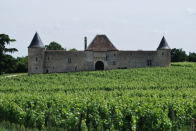
Built at the end of the 12th century, its old name was "Freytets" which means "fruit trees". This name comes from its well-exposed lands, suitable for growing vines. In the 19th century, it took the name of Château d'Eck, from the name of a former owner.
This castle has a medieval allure with its 4 towers and its surrounding wall. In 1302, Bertrand de Goth stayed there. This illustrious Bordeaux character will become the first pope of Avignon in 1305 under the name of Clément V.
4.Saint-Pierre Church of Cadaujac
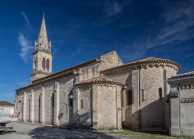
Saint-Pierre de Cadaujac church today has three naves and three apses. It does not have a transept, which deprives it of its cross plan. According to Father Pierre Abrard, the early church had one. The chevet located in the axis is deviated towards the north compared to the nave. Its structure is old, there are places, despite the plaster that covers it, a rubble stone apparatus.
The Saint-Pierre de Cadaujac church has little or no foundations, as is generally the case with Romanesque buildings, which gives it a certain fragility. In addition, it is built on relatively unstable soil with high humidity.
The gutter walls of the nave are built in uncertum opus except the western end of the north wall which is made up of a more regular medium device. These small stones are said to be partly a Gallo-Roman re-use. The rubble stones of the apse and apses allow this part to be dated to the eleventh century3.
Several traces of tearing of the old buttresses are visible since the restoration carried out by Mr. Errath in 1995 after the removal of the grayish whitewash which covered the walls.
We note, on both facades, the presence of a small narrow window with a notched monolithic lintel located in each eastern bay. Due to their craftsmanship, one can think that they must have been two of the original bays of the building. The current large windows do not correspond to the buttresses. It can be deduced from this that at least two of the four bays of each facade would in fact be extensions of the original small bays.
Originally, the two sides then probably had three small bays each. The narrowness of their opening is explained by the fragility of the small rubble stone walls characteristic of the eleventh century. From the twelfth century, it was preferred to build in a more regular apparatus which consequently ensured greater solidity.
The church had to be framed given the fragility of the rubble stone walls. The traditional Romanesque semicircular vaults were much too heavy for this type of wall. It also must have been much lower than it is today, judging from the low height of the original buttresses.
The small rubble walls are in fact the walls of the side walls of the church, which makes it difficult to assume that they were built in the 17th century because at that time they would have been built in a medium scale. However, building a three-aisled church in a small village is quite unusual for this era. It should be noted, however, that the original three-aisled plan is found in the churches of Saint-Martin in Villenave d´Ornon, Sainte-Croix in Bordeaux and Saint-Seurin in Bordeaux. The reason for this construction with three naves, in particular for Villenave d´Ornon and Cadaujac, is undoubtedly linked to their geographical situation which places them on a very busy road to Saint-Jacques de Compostelle.
VI.History
The Second Empire
The Second Empire was a time of material prosperity for Cadaujac.
1)Between 1854 and 1856, the Bordeaux-Marseille railway line passed through Cadaujac, which obtained a station and saw the construction of a “hotel de la gare”.
2)1855: the church is finally rebuilt and the cemetery is transferred to Chemin Truchon in 1856.
3)1858: the new town hall and the schools are built.
4)Château Malleret, built in 1860, receives visits from Napoleon III on several occasions. It is equipped with a very beautiful pier which was sometimes used by Cadaujacais when that of Grima was impracticable and which is sometimes counted in the number of ports of Cadaujac.
5)In 1868, the producers of wines are, for Graves, Truchon, Pontric, Lamotte, Fourgeau, Bardins, Valleroux, Cadaujac (Saige), Gourdin, Plombard.
6)Palus wines: Malleret, Laisné, Droit, Le Plan, Galibert, Rivière, Laroussie, Lagavatchosse, Callot, Ferbos.
7)There are 273 hectares of vines planted. We notice that the Palus is more important than the Graves, but at this time it is still the edges of the Garonne which are the most populated.
8)1870: the castle of Saige belongs to the count of Noaillan. It is still a superb building with a rotunda surmounted by a terrace, surrounded by a park with sumptuous massifs. It is surrounded by a vineyard of red wine.
9)On the other hand, the Château des Fougères is nothing more than ruins. The remains of a square tower and a 15th century fireplace attest to its glorious past.
10)When the Franco-German war of 1870 broke out, Cadaujac had 1,000 inhabitants. Eleven of them will remain on the battlefields.
11)Note a very heavy flood in July 1875.
From the twentieth century to the present day
At the start of the twentieth century, connections with Bordeaux were still difficult. There is a train in the morning at 7 a.m. The trip is most often made by means of a steam "gondola" which docks at 8 am at the port of Grima and drops off travelers on the Richelieu quay in Bordeaux. On the road side, "stagecoaches" stop at Le Bouscaut.
1)The municipal festival is held once a year, on the Place du Bouscaut, in addition, the town gives a party to the town, the feast of Saint Louis.
2)During World War I, Cadaujac lost 45 of his children in combat. It is the most affected of the townships in the canton.
3)1920: Domaine des Places is donated to the State by the Henry family. We now know the area under the name of "Colonie Henry" because it accommodated orphans until the war in Spain. In 1938, it accommodated Basque-Spanish refugees. It was sold in 1942.
4)From 1920 until 1955, the T.E.O.B. serves the city by means of the suburban tram line B, from Place de Bourgogne to the terminus of Chemin Truchon.
5)1928: The town is electrified.
6)1929: The Sporting Club Cadaujacais is created by Henry Pazot, Etienne Barbot and Gérard Eyrem. The land is the one we still know and which was originally a meadow belonging to Mr. Salvané.
7)A strong flood was reported in 1930.
8)1939: there are 1,200 inhabitants in Cadaujac.
9)1956: the new schools are built.
10)1967: there are 2,000 inhabitants in Cadaujac.
11)1970: the A61 motorway crosses the town, permanently changing its face.
12)In the early 1980s, the "La Clairière à Julia" and "La Péguillère" housing estates considerably increased the number of Cadaujacais.
VII.Other information
A 1st flower for Cadaujac!
Following the visit of the regional jury of the "Flowered Cities and Villages" label to the town on July 13, 2012, the jury decided to award the 1st flower to Cadaujac!
The regional award ceremony for the "Villes Fleuries" label took place on February 15 in Saint-Vincent de Tyrosse (40).
This distinction is an encouragement to continue the efforts we have undertaken to present a flowery commune, concerned with preserving the environment and improving its living environment.
The objectives pursued through this “Flowered Cities and Villages” label are the improvement of the environment and the practices leading to sustainable development, the protection and enhancement of the natural heritage while maintaining a quality built heritage enhanced by suitable flowering.
This award highlights the daily efforts made by municipal staff to maintain and beautify our municipality as well as the quality of the gardens and flowered balconies of the participants in the municipal competition. A big thanks to all of you !
Sources: http://www.mairie-cadaujac.fr/cadaujac/patrimoine.html
VIII.Contact information
Cadaujac town hall address :
Cadaujac Town Hall
3 place de l'Église
BP 29 33140 Cadaujac
Mayor : Francis Gazeau (Mandate : 2014-2020)
Mail: mairie@mairie-cadaujac.fr
Phone number: 05 57 83 82 00
Fax: 05 57 83 82 01
Website : http://www.mairie-cadaujac.fr
Sources : http://www.cartesfrance.fr/carte-france-ville/33080_Cadaujac.html
